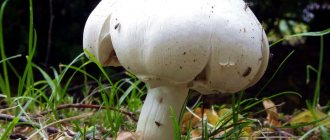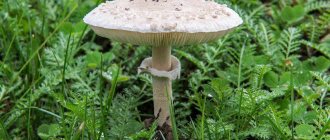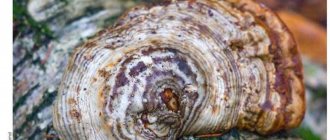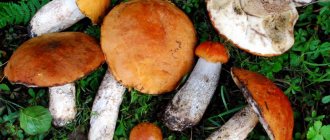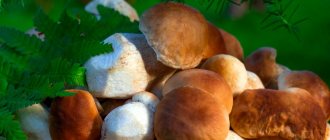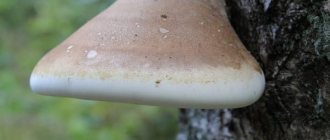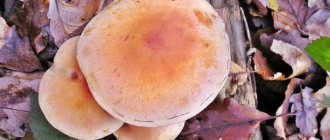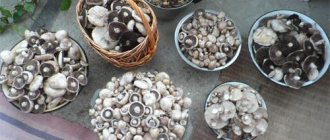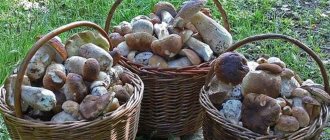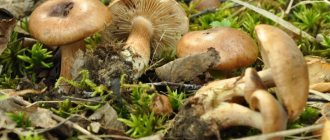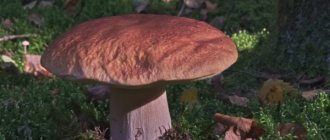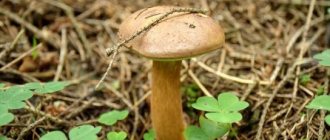Everyone who, having grabbed a basket, goes into the Crimean forest for a quiet hunt should know the poisonous mushrooms of Crimea. There are many “experts” among mushroom pickers who have come up with their own way of testing a mushroom for toxicity. Quite a few of these “smart guys” have to be literally brought back from the other world. Below are the ten most dangerous poisonous mushrooms in Crimea (in the list they are sorted by the degree of increasing toxic properties), by familiarizing yourself with which you will protect your life and the lives of your family and friends.
Poisonous mushroom of Crimea No. 1 - satanic mushroom
This is a relative of the generally recognized king of the mushroom kingdom - boletus, is not deadly, but can cause serious gastrointestinal disorders. It's funny, but the mushroom got its ominous name from Herold Lenz, a German mycologist who described it in detail in 1831. At this time, the researcher felt very sick and, knowing about the poisonous properties of the mushroom, considered the cause of the illness to be its effect on the body.
The main threat to a novice mushroom picker is its impressive and very appetizing appearance, which tempts you to put the mushroom in the basket. But such carelessness can cause nausea, vomiting, severe abdominal pain, diarrhea, low blood pressure, dehydration and other negative consequences. And its use repeatedly or in large quantities will cause damage to the liver or kidneys.
In Crimea, devil's mushrooms grow from July to October in oak and mixed forests of the foothills. There you can also find similar and equally toxic boletuses: pink-purple and pink-golden.
Be very careful! The satanic mushroom is very similar to edible boletus mushrooms, especially oak mushrooms.
Features of the region
Crimea has an unpredictable climate. Local mushroom pickers know that the season starts differently every year. Thanks to the warm weather and lack of precipitation, mushrooms are collected until the first month of winter.
They are found in forests, steppes, and mountain glades. The weather is different in different parts of the peninsula, so species grow either delayed or accelerated. The season lasts from mid-spring to mid-autumn. During this period, species with valuable taste qualities bear fruit. Winter honey mushrooms rest quietly until next year, and the gray row bears fruit for a long time.
Poisonous mushroom of Crimea No. 2 - knight's mushroom or red fly agaric
Sometimes in the summer and autumn in the forests of the mountainous Crimea you can find fly agarics. Eye-catching, various shades of purple or red, large caps covered with white flakes on graceful legs with flirty “aprons” gave it the name - red fly agaric.
Such a bright appearance has made this mushroom popular in folk art, and even mushrooms on playgrounds are invariably painted in its colors.
But the noticeable attractiveness of the mushroom in this case is a clear warning: stop, I'm poisonous! Already since the 13th century, fly agaric toxins have been used to kill flies, hence its Russian name.
The poisons contained in the fly agaric affect the nervous system, causing strong hallucinations; this property was used by shamans of different nations to enter a trance. In medieval Europe it was also called the knight's mushroom.
Often before a tournament or battle, many knights consumed his dried caps in small doses, losing their sense of fear and becoming less susceptible to pain. Despite its strong toxicity, fly agaric has found wide use in folk medicine. But be careful - self-medication with its drugs is dangerous, the mushroom is still very poisonous, and severe poisoning is possible.
The main symptoms of severe mushroom intoxication: nausea, dilated pupils, blurred vision and the appearance of hallucinations. In severe cases: delirium, convulsions, coma.
Poisonous mushroom of Crimea No. 3 - panther fly agaric
This mushroom is less noticeable and inferior to its fellow not only in brightness, but also in size. The caps, colored gray or brown with an olive tint, are covered with numerous white flakes, giving it a resemblance to the spotted pattern on the skin of a leopard.
Despite its modest appearance, its range of poisons and their concentration are several times higher. There is a popular belief that due to its strong toxicity, you will never see flies and other insects near the mushroom, which, according to legend, die even if they smell it. Symptoms of poisoning are similar to those of red fly agaric poisoning, due to the high content of poisons, they occur faster and are more acute, requiring immediate medical intervention. On the peninsula, the panther fly agaric grows in hornbeam-beech, oak-hornbeam and mixed forests in the summer-autumn period.
Attention! The mushroom is easily mistaken for edible fly agarics: pink and tall.
Where and when to pick mushrooms
Crimeans recommend going for mushrooms to the main natural attraction of the peninsula - Mount Ai-Petri. There are whole mushroom glades there. In general, the mountains of Crimea please mushroom pickers at an altitude of 300 - 700 meters with a good harvest. The most popular places among mushroom pickers:
- Vicinities of the village of Luchistoye;
- Mount "Demerdzhi";
- The territory from Feodosia to St. Crimea;
- Steppe terrain;
- On the road Sevastopol - Bakhchisarai.
Naturally, it is not enough to know where to look for nutritious plants. It is worth understanding that at certain times of the year, even in the most mushroom-filled places, it is impossible to find what you are looking for. Mushrooms grow seasonally. In Crimea this is autumn and summer, some species are found in early spring.
Mushrooms growing in summer
Some types of mushrooms appear in Crimea at the beginning of spring, but the best season is considered to be the summer period. And not immediately after the rain, but a few days later, around 4. When the weather is good, it will get warmer. Experienced mushroom pickers advise not to rush, but to wait. Then you will find a good “catch” of tasty and large plants.
In summer, there are especially many different mushrooms on the peninsula: saffron milk caps and boletus, puffballs and honey mushrooms, mountain porcini and russula. You can find quite a few not quite familiar types: single barrels, cattails, moss mushrooms, rare ones, and so on. There are especially many champignons, striking with their huge size. Particularly successful mushroom pickers find boletus and boletus mushrooms. The truth is far from aspen and birch trees, but in coniferous forests and beech thickets.
September, October mushrooms (autumn)
Autumn mushrooms on the peninsula are mostly pleasing until October, but some species grow until frost. As a rule, only the gray rows (mice) and autumn honey mushrooms “survive” until this time. In October you can still find boletus and late chanterelles, but only before the cold weather. In September there are a lot of milk mushrooms and so-called horned mushrooms.
Both summer and autumn representatives of the mushroom world in Crimea grow in mixed plantings, on mountain plains, foothills, and steppes. And some species are in close proximity to human settlements. In any case, when going on a “hunt” you should acquire basic knowledge about edible and poisonous plants.
Poisonous mushroom of Crimea No. 4 - Patouillard fiber
A small mushroom with a cap diameter of 2-7 cm, named after the French pharmacist-mycologist, can easily outperform the red fly agaric, which looks like a real giant in its toxicity. Both mushrooms contain the same toxic substances, only their concentration in the fiber is 20 times higher!
This mushroom can be found from May to October in the beech or hornbeam-beech forests of the mountainous Crimea (singly or in small groups). The color of the silky-fibrous cap changes with age from white or light cream to red-brown.
Light-colored caps that are cut and left in a basket for several hours become covered with bright red spots over time.
Another interesting feature of the mushroom is its aroma, which can cause profuse salivation in lovers of strong drinks. When broken, the pulp of mature mushrooms has a pungent odor of alcohol, but this is not worth rejoicing at all, no matter how much of a fan of Bacchus you are - you have received a sure signal of mortal danger.
The symptoms of poisoning are the same as those from the red and panther fly agarics, only they are much more pronounced and, if medical assistance is not provided within half an hour, death is almost inevitable.
In the Crimea, the following related types of fibers are found: curly, fissured, earthen - having a similar appearance, they contain a lower concentration of poisons, but, nevertheless, remain dangerous mushrooms.
Attention! Beginning mushroom pickers may confuse fiber with some types of champignons or russula.
Technology for growing champignons in the garden
Those who want to grow mushrooms in an open area need to know some nuances, since champignons are quite whimsical. They do not like bright light, so any shaded area is a suitable place to build beds. To protect the soil from drying out, you should make a canopy.
The first step is to prepare the compost. To do this, lay layers of straw, manure and litter. Water every day, avoiding drying out. After 3 weeks the compost will be ready.
It is necessary to sow mycelium (a kind of mushroom seeds that can be purchased in the store) onto the loosened soil, cover with a 5-centimeter layer of compost and water. Fruiting occurs after 2.5 months.
For those who plan to grow mushrooms all year round, it is important to know that champignons do not need lighting, so for the winter they can be moved to any damp and warm room with an air temperature of at least +15 degrees.
Poisonous mushroom of Crimea No. 5 - whitish talker
Small, only 1.5-4 cm in diameter, but clean snow-white caps of this mushroom, growing in picturesque groups against the contrasting background of the litter of mixed or pine forests of the mountainous Crimea, look very attractive and are often found from September to November.
Visible from afar, with a pleasant smell and taste, they seem to beckon to the mushroom picker: take me, please, eat me - you won’t regret it! But if you make this mistake, you will definitely have to repent. Despite its fragile, graceful beauty and external harmlessness, the mushroom is very poisonous and has a high content of muscarine toxins, the concentration of which is many times higher than in the red and panther fly agarics.
Attention! The mushroom is easily confused with some types of edible talkers that have small caps.
Inedible species leading to gastrointestinal upset
Consumption of conditionally edible or inedible mushrooms is fraught with severe food poisoning, and such types are especially dangerous for children.
Volnushka pink
The mushroom has a dense funnel-shaped cap with characteristic rings and a thin mucous layer. It is distinguished by its light red color and darkening of the flesh, which can be observed upon tactile contact.
False fox
False foxes (orange talkers) are very similar to real ones. They have caps that are brighter in color and resemble a funnel in shape. The shade ranges from bright orange to orange-brown with a copper tint. The edges of the cap are smooth and even, their size does not exceed 3-6 cm in diameter. The pulp of the false chanterelle does not have a very pleasant aroma; when pressed, the color does not change.
White row
This type of row is often confused with the white pig, since it has the same color and similar structure. The mushroom has a smaller size and a pungent radish odor, which begins to exude a fruiting body as it ripens.
Remember!
It is noteworthy that young rowers do not smell, and if you eat them, you can get a severe, protracted intestinal disorder.
Leopard print row
The mushroom has a spherical cap, white-gray with a silver tint, up to 10 cm in diameter. Gradually the cap becomes more convex, then completely spread out with thin edges turned down. There are small scales on the surface, spreading out in flakes in a circle. Rowers grow in small colonies, forming “witch rings”, and are rarely found alone.
Satanic mushroom
Much more serious complications can occur after consuming a satanic mushroom, which is confused with boletus mushrooms. A thick red leg, an equally massive light lumpy cap and a pungent smell of rotten onions in case of mechanical damage to the fruit will help you not to be mistaken about it.
Champignon dark scale
You should be especially careful with champignons that have several inedible look-alikes. The dark-scaled mushroom has a loose spherical cap, completely covered with small brown or mustard-colored scales. If you break this small fruit, you will notice how its flesh begins to turn yellow, emitting a rotten smell, while real champignon always smells pleasant, causing an association with the aroma of damp wood.
Complications after eating inedible mushrooms can be detrimental to your health. Thus, dehydration of the body can develop against the background of frequent vomiting and diarrhea, disturbing the electrolyte balance.
Important!
In such situations, immediate contact with specialists, increased drinking regimen and the use of sorbents, as well as special rehydration solutions necessary to replenish lost fluid, are indicated.
Poisonous mushroom of Crimea No. 6 - waxy talker
They differ from the previous species in the large size of the cap - 4-10 cm and dirty white color, in a more mature age - creamy and yellowish, often with well-recognized waxy spots, for which they were given such a name.
Fruitful bodies form in May-October in deciduous and mixed forests of the mountain and foothills of the peninsula. For the “great” mushroom pickers who rely not on knowledge, but on the method of determining the edibility of a mushroom by smell and test on the tongue, we remind you once again - this method does not work at all.
Just as in the case of its relative described above, the waxy talker has a very pleasant taste and aroma, but the concentration of poisons in it is even greater, and many experts classify the mushroom as deadly.
Symptoms of mushroom poisoning: profuse sweating, vomiting, decreased heart rate and blood pressure, and the victims do not experience a loss of strength, but, on the contrary, they become aggressive and frenzied.
There is evidence in the literature, as in the case of the red fly agaric, that in the old days warriors, taking a small amount of broth from the talker, became immensely courageous and unstoppable on the battlefield.
Attention! This mushroom can be mistaken for edible Mayweed, cherry blossoms and some types of edible talkers.
Edible mushrooms
In Crimea there are edible mushrooms, of which there are an incredible number of species and varieties. Each type deserves separate consideration. The most common fungal representatives are the following types of mushrooms:
Duboviki
Description. Oak trees are distinguished by yellow-brown, sometimes gray-brown caps, in which it has a cushion-shaped shape in youth and a spherical shape in maturity.
Where and when does it grow? You can collect oak trees as early as May by going to deciduous groves to see the oak trees. Popular places for collecting oak trees are the areas of Sevastopol, as well as oak forests and the mountainous part of Crimea. The harvest season ends in June.
Varieties. Speckled oakweed is also found. It has a hemispherical or cushion-shaped cap, 5-15 cm in diameter. It darkens when pressed. The color of the cap can be chestnut-brown, red-brown or black-brown. The length of the leg reaches up to 10 cm. It grows from August to September in deciduous and coniferous forests.
Doubles. Speckled oakberry can be confused with a poisonous satanic mushroom.
Morels
Description. Morels have a cellular structure, ovoid-round caps, with a predominant yellow-brown tint. The mushrooms grow from below to the stem and are hollow inside. The cylindrical legs are slightly expanded downwards, their color can be white, yellow-brown or light yellow. The flesh of the mushroom is brittle and white. They are distinguished by a mushroom aroma and pleasant taste.
Where and when does it grow? Mushrooms growing in groups are found in areas of forest fires, mixed and deciduous forests. They collect fruiting bodies from the beginning of March, going to mossy ditches, clearings or forest edges.
Varieties. The varieties of morels that grow in this area include the common morel. This is an edible mushroom with a spherical brown cap, 8 cm in diameter. There are large cells on the surface of the cap.
Doubles. False morels have similar external characteristics, but they have a dark olive tint to the cap, and their smell is very unpleasant.
Russula
Description. There are a large number of russulas. They are distinguished only by the colors of the caps, but their shape is similar: straightened with slightly downward curved edges, up to 10 cm in diameter.
Where and when does it grow? The russula collection season begins at the end of August and lasts until the end of October. Mushrooms prefer deciduous and coniferous forests, swampy river banks, and young birch groves. You can find russula in large quantities in Belogorsk in the Old Crimea region.
Varieties. There are a huge number of varieties of russula:
- Golden yellow. It is distinguished by a thin fleshy structure, a convex shape of the cap, with a diameter of up to 9 cm. The cap can be yellow, red-pink, or dark red or white. A cylindrical or club-shaped white stalk in young mushrooms, yellow-gray in mature specimens.
- Greenish. An edible mushroom with a hemispherical, later flat, gray-green or dark green cap, up to 15 cm in diameter. White cylindrical leg. White pulp with a faint odor and nutty taste.
Russula golden yellow
Russula greenish
Greenish russula is confused with poisonous toadstool
Doubles. Greenish russula can be confused with toadstool, which is a dangerous mushroom.
Saffron milk caps
Description. Saffron milk caps are mushrooms with a surprisingly light yellow or orange colored cap, 5-18 cm in diameter. The hat is round. There are also bluish-green or red saffron milk caps. The mushroom's stem and cap have the same shade. The height of the hollow leg reaches up to 9 cm.
Where and when does it grow? Mushrooms grow from mid-July to October. In Crimea, mushrooms are found in the forests of the Rybachy and Southern coasts. They grow near coniferous trees, preferring pine and larch trees.
Doubles. The doubles of saffron milk caps include the pink saffron milkweed and the aromatic milkweed.
Rows
Description. The rows have a hat-footed structure, making this mushroom difficult to confuse with other specimens. The brown, white, green, yellow or red cap may resemble a cone or bell when young. As it grows, the cap straightens, becoming flat and outstretched. The diameter of the cap varies from 3 to 10 cm. The height of the stem does not exceed 10 cm.
Where and when does it grow? Ground mushrooms grow singly or in groups. These autumn mushrooms form mycorrhizae with coniferous trees. They are much more common near pines than under larches, spruces and firs. It is recommended to go for mushrooms at the end of August and until the end of October. In the area of Kolchugino and the Crimean Observatory there are a large number of gray rowers.
Varieties. A variety of this mushroom is the gray row (mice). They are distinguished by a gray rounded cap, which as the mushroom matures becomes flat and uneven. The gray leg with a yellow tint reaches up to 15 cm in height. The diameter of the cap is 4-12 cm.
Doubles. A dangerous analogue of a mushroom is considered to be a poisonous row with a convex cap with unfolded edges. It has an unpleasant floury odor and white flesh.
Dung beetles
Description. Dung beetles are mushrooms with a bell-shaped cap with small scales on the surface. The leg is thin, fragile, hollow inside. When the mushroom ripens, the cap dissolves, and a black pulp or stain remains in place of the mushroom, forming a ring.
Where and when does it grow? The dung beetle can be found in garden beds, near residential buildings, in city parks and even in garbage dumps. They prefer fertilized soils rich in plant remains.
Varieties. There are several types of dung beetles:
- Ordinary. Young mushrooms have a cylindrical cap with white scales. As it matures, the cap opens, acquiring a bell-shaped shape, reaching up to 3 cm in diameter. When ripe, it turns black.
- White. The bell-shaped cap with white scales on the surface reaches up to 10 cm in diameter. The height of the mushroom itself can exceed 15 cm.
Common dung mushroom
White dung mushroom
shimmering dung beetle mushroom
Doubles. Dung beetle is a mushroom that has no poisonous counterparts. But outwardly it is similar to the conditionally edible dung beetle.
Raincoat
Description. The puffball has a spherical or pear-shaped fruiting body with a closed structure. The mushroom has a dense skin and has spines that fall off over time. When the puffball ripens, chambers are formed inside it that contain spore powder. The white flesh is firm and minty, yet meaty.
Where and when does it grow? It is recommended to go for mushrooms at the end of summer; they grow until late autumn, along roads, in mixed and coniferous forests. In Crimea, raincoats are searched for in foothills and areas with rotting wood.
Doubles. False puffball with a spherical shape, but tough flesh and skin - an inedible counterpart to the regular puffball.
Milk mushrooms
Description. Mushrooms that have a flat-convex cap when young, and when mature its shape becomes funnel-shaped. The cap of a milk mushroom can reach from 5 to 20 cm. The cap is located on a low stem, which does not exceed 7 cm in height.
Where and when does it grow? You can find milk mushrooms in mixed and coniferous forests, near birch forests, in clearings, edges and clearings. They are most often found in Simferopol, Bakhchisarai and Belogorsk regions.
Varieties. Several varieties of milk mushrooms are found on the territory of the Crimean Peninsula:
- Oak. An edible mushroom containing bitter juice, therefore requiring preliminary heat treatment. The reddish-orange cap is concave in the middle and has light flesh. The diameter of the cap is up to 6 cm, the height of the stem is up to 7 cm.
- Peppery. At first the cap is slightly convex, then becomes more funnel-shaped. The edges are slightly bent, then straighten out, becoming wavy. The skin is cream or white, covered with reddish spots. The height of the solid white leg reaches up to 8 cm.
- Dry. Edible mushroom with a white smooth surface. In young mushrooms it has a slight tint of blue. The diameter of the cap is up to 20 cm. The shape of the cap is initially convex with a small tubercle in the center and the edges turned down. As it ripens, the cap opens and cracks in dry weather.
Oak milk mushroom
Pepper milk mushroom
Dry milk mushroom
Doubles. Edible milk mushrooms can be confused with conditionally edible species: pepper milk mushrooms, oak milk mushrooms.
Single barrel
Description. The single-barrel mushroom is dominated by a funnel-shaped cap, shaped like a chanterelle. The hat is gray, brown, dark gray, sometimes light gray. The fruit body is elastic and dense, 12-15 cm in diameter. The largest mushroom has a stem with a diameter of no more than 2 cm. Outwardly, it seems that it does not exist at all. The mushroom is sometimes pressed tightly to the soil.
Doubles. The single barrel does not have poisonous counterparts.
Where does it occur and when? Mushrooms like moisture; in summer, during drought, you don’t have to look for them. They begin to grow after prolonged fogs and heavy rains. They bear fruit abundantly in the spring before the heat sets in and in the fall when the evenings are cold. It is found in the steppes near livestock farms, along roads, banks and streams. They grow in groups.
Boletus
Description. At a young age, the boletus has a hemispherical cap, which then becomes cushion-shaped, reaching up to 30 cm in diameter. The skin is dry, velvety or felty. The club-shaped leg reaches up to 22 cm in height. The surface of the leg is covered with black or brown scales.
Where and when does it grow? Boletuses are found from the end of June to the end of October. They grow exclusively with partner trees, forming mycorrhizae. You can find mushrooms under the following trees:
- poplars;
- oaks;
- aspens;
- fir trees;
- willow;
- beeches;
- birches.
Varieties. There are several boletuses, differing only in the color scheme of the caps: red, white, red-brown.
Doubles. False boletus is called bitter and pepper mushroom.
boletus
Description. Young mushrooms have a white hemispherical cap; in adulthood, it becomes cushion-shaped, acquiring a dark brown tint. The flesh of the mushroom is white, dense, darkening when broken or cut. The mushroom cap reaches up to 18 cm in diameter. The leg is cylindrical, white or gray with dark gray longitudinal scales on the surface.
Where and when does it grow? Mushrooms grow both singly and in small groups from early May to mid-autumn. They grow in any light deciduous and mixed forests with birch trees. Often found on forest edges and open clearings.
Varieties. There are several varieties of boletus:
- Bolotny. Grows in moist soils. It has a light gray or light brown cap and loose flesh.
- Multicolored. Mushroom with an orange, light brown or pinkish cap. The surface of the fungus becomes slimy after rains. Boletus mushrooms have white legs, sometimes with gray scales.
- Ordinary. Reddish or brownish cap. A massive, dense leg with gray scales located on the surface.
Marsh boletus
Boletus variegated
Common boletus
Doubles. The bile fungus is considered to be a twin of the boletus, the stem of which is gray or pockmarked, and the cap is white-gray.
Rogatiki
Description. Rogatik is a fruiting body that grows in vertically branched tubes; it has neither a stem nor a cap. It is simply impossible to confuse this specimen with other mushrooms.
Varieties. There is a yellow hornet, which is characterized by a yellow color, up to 20 cm in height and up to 15 cm in diameter. Many branched bush-like branches, distinguished by their cylindrical shape, grow from a thick white stalk. The pulp is moist, off-white.
Where and when does it grow? You can start searching for horned birds as early as the end of August, going to humid coniferous forests. Mushrooms choose to grow in lingonberry meadows, rotten tree debris, moss or bark.
Doubles. The horned one has no doubles.
Mosswort
Description. A young flywheel has a convex or semicircular cap with straight edges. Over time, the shape of the cap becomes cushion-shaped, reaching a diameter of 4-20 cm. Moss fly mushrooms have a bare, velvety, sticky or wet surface, sometimes covered with small scales. The color can be different, such as chestnut, olive yellow, brown, lemon or dark yellow.
Where and when does it grow? Mushrooms grow alone. They grow in forest clearings and edges, in mixed, deciduous and coniferous forests, creating mycorrhizae with partner trees. You can find them from the beginning of July to the end of October under linden, alder, chestnut, beech, spruce, hornbeam, and pine.
Doubles. Moss mushrooms do not have poisonous counterparts, but they are often inadvertently confused with pepper or gall mushrooms.
Butter
Description. There are small and medium-sized mushrooms that look like flywheels. At a young age, they are attracted by a spherical or conical cap, which then straightens out, becoming cushion-shaped, reaching up to 15 cm in diameter. The mushroom has a cylindrical stalk, up to 10 cm high. The skin-film is shiny and sticky. The flesh is soft but dense.
Where and when does it grow? Butterflies are found under coniferous trees, less often near birch and oak. It is recommended to go for mushrooms from the beginning of summer until mid-October, visiting the Ai-Petrit zone of Mount Demeredzhi. Boletus are also found in the Stroganovsky district and the village of Zelenogorskoye.
Varieties. On the Crimean Peninsula you will find several varieties of butter:
- Ordinary. A mushroom whose cap is brown-violet, red-brown, chocolate brown or yellow-brown. The diameter of the cap reaches up to 12 cm, the height of the stem is up to 11 cm.
- Grainy. The convex rusty cap eventually takes on a pillow-shaped shape, distinguished by a yellow-orange hue. The diameter varies from 4 to 10 cm.
Common oiler
Grainy oiler
Pepper mushroom is one of the boletus's doubles.
Doubles. The twins include the pepper mushroom, which has a convex cap with a smooth, shiny surface.
Champignon
Description. Champignons are mushrooms with massive caps. At an early age they have a round shape, then become prostrate and flat, reaching up to 10 cm in diameter. The caps are brown, white, or brownish. They are characterized by a smooth surface, an even and dense stem.
Where and when does it grow? You can find champignons as early as April in the forest on the bark of rotting trees, in meadows and fields, near places where people live. Fungi form ring-shaped colonies. The harvest lasts until October.
Varieties. The following types of champignons are found:
- Ordinary. An edible mushroom with a white cap, 8-15 cm in diameter, hemispherical in shape and edges strongly curved inward. The leg is straight.
- Field. Grows in forest clearings. It has a bell-shaped shape, up to 20 cm in diameter. The hat is white or cream. Leg height – up to 10 cm.
- Forest. Young mushrooms have an ovoid-bell-shaped brown-brown cap, which over time becomes flat-prostrate, reaching up to 10 cm in diameter.
Common champignon
Field champignon
Forest champignon
Doubles. The champignon's counterpart is a false representative - a poisonous mushroom, upon which light yellow spots appear when pressed. The cap of the false champignon has a brown spot in the center.
Chanterelles
Description. Common mushrooms with excellent taste. It is very difficult to confuse them with other mushrooms because they have a unique appearance. Chanterelles have concave caps with wavy edges. Color varies from yellow to orange. The diameter of the cap is up to 10 cm.
Where and when does it grow? Chanterelles grow from spring to late autumn. You need to look for them in forests, especially coniferous ones. A large harvest can be found in the area along from Sevastopol to Bakhchisarai.
Varieties. There are a large number of chanterelles, but in the Crimea the following varieties are found:
- Ordinary. Light yellow or orange cap, 2-12 cm in diameter. The flesh is fleshy, yellow at the edges and white on the cut. When consumed, a slightly sour taste is felt.
- Gray. An edible mushroom with wavy edges on the cap and a depression in the center. The diameter of the cap is up to 6 cm. The flesh is elastic. The cap is gray or brownish.
Common chanterelle
Gray chanterelle
Chanterelles are similar to the orange talker
Doubles. Externally, chanterelles are similar to the inedible Orange Govorushka and the poisonous Olive Omphalote.
Polypores
Description. Polypore is a mushroom with a light brown or grayish-brown cap. The length of the mushroom is up to 50 cm. It consists of numerous branched legs, each of which has white caps. A young tinder fungus has a rounded cap; in a mature mushroom it becomes flat-convex.
Where and when does it grow? You can go for tinder fungi in mixed forests - mushrooms grow on tree trunks and stumps. The harvest season begins in August and lasts until November.
Varieties. The following types of tinder fungi can be found on the Crimean Peninsula:
- Winter. The mushroom has a yellow-brown cap with a predominantly flat-convex shape. The leg is gray-yellow, hard. It grows even in December.
- Umbrella. The diameter of the cap reaches up to 40 cm. The mushroom has flat, light, round caps - pressed in the center, collected into fruiting bodies.
- Sulfur yellow. The diameter of the yellow-orange fruiting bodies is close to 50 cm.
Winter tinder fungus
Umbrella tinder fungus
Sulfur-yellow tinder fungus
Doubles. The mushroom has a false twin, which has a rounded fruiting body, 20-26 cm in diameter. It can be distinguished from an edible mushroom by its matte, uneven, black or dark gray surface.
Caesar's mushroom
Description. Caesar's mushroom (or Caesar's mushroom) is dominated by an interesting shape and a bright tip. When young, the cap is ovoid or semicircular in shape, then it becomes flat with velvety edges. There are specimens with a bright yellow or light red cap, 8-20 cm in diameter. The stem of the mushroom is light, almost white, 8-12 cm high, 2-3 cm in diameter. The flesh of the cap is fleshy, juicy, yellow in color.
Doubles. Due to inexperience, the caesarean mushroom is confused with the red fly agaric. They are indeed very similar, but the caesarean mushroom does not have white spots on the surface of the cap.
Where does it occur and when? Caesar's mushroom grows in light deciduous forests under old trees or on the border of forests and meadows. The mushroom grows adjacent to beech trees, chestnut trees, hazel trees or birch trees, and less often with coniferous trees.
Honey mushrooms
Description. Mushrooms with cream, reddish and yellowish caps, on the surface of which there are small scales. A distinctive feature is a thin and long stalk, the height of which reaches up to 15 cm. It can be light honey, light beige or dark brown, depending on the age of the mushroom.
Where and when does it grow? Honey mushrooms are collected from the beginning of May until October. Mushrooms grow with bush plants and near trees. They can be found in groups on old stumps in the forest, as well as in meadows and forest edges. Mushroom pickers can go for honey mushrooms to the steppe zone near the Donuzlav and Sasyk estuaries.
Varieties. The following types of honey mushrooms grow here:
- Lugovoy. At a young age, the mushroom has a convex cap, which over time becomes dense, and its edges are uneven. The mushroom has light flesh, a pleasant taste, and an almond or clove aroma.
- Winter. The edible mushroom has a convex cap, 2-10 cm in diameter, and the height of the stem reaches up to 7 cm. The caps are yellow, brown or brown-orange. The pulp is white, predominantly light yellow. Leg height – up to 10 cm.
- Autumn. Growing singly or in groups. Autumn honey fungus grows on a high stalk up to 10 cm. The diameter of the cap varies from 3 to 15 cm.
- Summer. An edible mushroom with a convex cap of a honey-yellow hue. The mushroom has dense, white flesh.
Honey fungus
Winter honey fungus
Autumn honey fungus
Summer honey fungus
Doubles. There are false honey mushrooms with orange or brick-red caps.
Ramaria yellow
Description. The fruiting body of yellow ramaria reaches a height of up to 20 cm, a diameter of up to 15 cm. The fruiting body is predominantly yellow. From the thick white stalk grow numerous branched, dense bush-like branches, which have a cylindrical shape. The pulp is moist, off-white. The smell of the mushroom is pleasant, the taste is mild.
Doubles. Yellow ramaria is similar in appearance to golden yellow coral; they can only be distinguished under a microscope.
Where does it occur and when? Yellow ramaria grows singly and in groups, grows in August-September on the ground in deciduous, mixed and coniferous forests.
Mountain white mushroom
Description. They are distinguished by large, fleshy caps, up to 20 cm in diameter. They can be completely white, but they also come in coffee-with-milk colors. The surface of the cap is smooth, and the bottom is covered with plates with bridges. The pulp is white or cream. The smell is pleasant, mealy.
Doubles. The smoky talker, found in the Crimean forests, is similar to it.
Where does it occur and when? Mountain porcini mushrooms grow in groups, usually under birch or pine trees. Prefers the soil of deciduous and coniferous forests. Grows from early summer to mid-October.
Poisonous mushroom of Crimea No. 7 - sulfur-yellow honey fungus
“Honey mushrooms are very friendly guys,” is how this mushroom is characterized by a Russian proverb. And indeed, for many lovers of quiet hunting, their large, dense families have become one of the most coveted trophies found in the forest. However, this friendly community also has its own false representatives who can cause serious harm to a person.
The most dangerous representative is the sulfur-yellow honey fungus, which received its name for its bright color similar to the color of the designated chemical element. You can meet from September to December in the forests and parks of the peninsula.
Very often on stumps, and a little less often on living trees or at their base, they form large dense groups of fruiting bodies.
Initial signs of poisoning: continuous vomiting, frequent loose stools, weakness, increased sweating. Headaches are possible. The toxins of the fungus are not destroyed by heat treatment and are especially dangerous for elderly and weakened people, in some cases they can be fatal.
Attention! The mushroom is sometimes confused with edible types of honey mushrooms: autumn, poplar, and sulphurous honey fungus. At the same time, it often grows next to the autumn honey fungus. They sometimes seem to intertwine with each other, and here you need to be especially careful. Not every mushroom picker is able to distinguish them.
The benefits and harms of champignons
Since spherical mushrooms are rich in folic acid, which is essential in the production of red blood cells, metabolism, and the functioning of the cardiovascular, nervous and digestive systems, they have a positive effect on the human body. In addition, acid plays an important role in a woman’s reproductive system, participating in the formation of the placenta and the healthy development of the fetus. The presence of amino acids, vitamins and minerals in the forest product also benefits pregnant women.
Mushrooms have low calorie content, high energy value, and contain a large amount of proteins and antioxidants, which makes them dietary and accessible to patients with diabetes. For example, champignons contain more B vitamins than fresh vegetables. Thanks to the large amount of plant fiber and beneficial properties, dishes made from this product not only quickly satisfy hunger, but also help improve metabolism. That is why nutritionists recommend eating champignons for those who want to lose extra pounds, as well as for strengthening muscle mass in the gym. In addition, the dietary product improves memory and concentration.
To prepare traditional Russian food from champignons, you should use sunflower oil, which is used for frying and seasoning all tubular mushrooms. Processing champignons includes both cooking and preparation for consumption.
When collecting champignons, it is important not to confuse them with their poisonous counterparts, which will be harmful to health. It is not recommended to collect mushrooms in unsafe areas (near industrial enterprises, highways, landfills), since the fruiting bodies absorb harmful substances from the surrounding atmosphere. A canned product made from raw materials that was stored incorrectly or in violation of the preparation technology can cause harm to health. It is advisable for pregnant women not to eat salted, pickled and dried mushrooms. If you have allergies or problems with the digestive system, you should also avoid the herbal product.
We also recommend reading:
Why milk mushrooms are useful and dangerous for the human body Time and rules for collecting milk mushrooms and other edible mushrooms Technology and secrets of growing champignons at home The most mushroom places in Volgograd and other regions of Russia
Due to the large amount of chitin, which is practically not absorbed by the body, experts do not recommend introducing champignons into children's diets.
Poisonous mushroom of Crimea No. 8 - brown-red lepiota
This mushroom can be described in the words of the Russian proverb: “Small and remote.” Indeed, its caps, covered with concentric circles of easily recognizable cherry-brown scales, are very small, only 2-5 cm in diameter.
On the peninsula it is usually found in October-November, most often in oak forests and parks. But only the prowess of this baby is worse than that of the fabulous Chernomor, and has very sad statistics: death occurs in almost half of the cases of its use, and the mushroom is accordingly classified as deadly poisonous.
Possessing a very pleasant smell of roasted almonds mixed with the aromas of flower honey, young fruiting bodies easily inspire confidence and do not arouse the slightest suspicion in an inexperienced mushroom picker.
True, with age, the smell of the mushroom comes into line with its reputation, turning the wonderful aroma into a real amber, filled with “refined” gasoline-acetone ions with an admixture of autol.
The concentration of fast-acting poisons in it is so high that even one cap is enough to kill a person. Symptoms of poisoning appear quickly within 10-15 minutes, and cardiac arrest can occur within 30 minutes, so medical assistance is not always timely.
To the gloomy reputation of brown-red lepiota, it should be added that modern medicine does not know methods for deactivating the poisons it contains, and the entry of fungal spores into the respiratory tract can cause severe damage to pulmonary-bronchial tissue.
This monster has a similar appearance, painted in more ocher tones - brick-red lepiota, which also poses a mortal threat to people. Fortunately, both types of mushrooms have no analogues with edible mushrooms.
Medium poisonous mushrooms
Names of less poisonous mushrooms in Crimea:
- purple boletus;
- pink wave;
- false chanterelle;
- white row;
- satanic mushroom;
- dark-scaled champignon.
Poisoning by these species causes stomach upset, mild vomiting, fever and other local symptoms.
- Purple boletus: large species, cap reaches 25 cm in diameter, stem - up to 15 cm in height. The shape of the leg is barrel-shaped, with a dome-shaped or flat cap located on top. It has dark blue spots, which are especially visible when pressed. When damaged, the light flesh changes its color to black and blue.
- Pink volnushka: representatives of the species have wide, flat caps with pink streaks. There is a depression in the middle of the cap. At the break the flesh darkens. The leg is cylindrical, hollow. The surface of the fruiting body is mucous, but dries out in hot weather.
- False chanterelle: it is distinguished from a real chanterelle by its leg. In dangerous species it is brighter and thinner. The pulp is light orange, with an unpleasant odor. The records are real, i.e. thin (lamellar hymenophore), and not folded (folded hymenophore) as in the common chanterelle.
- White row: it is often confused with champignon. The differences between this species and the edible mushroom are as follows:
- light plates (to match the color of the pulp);
- characteristic radish smell;
- flat, outstretched hat.
- Satanic mushroom: looks like a boletus mushroom. It has the same barrel shape. The cap is white or cream, sometimes grayish. The stem is barrel-shaped, darker in color, often red. The flesh of the satanic species darkens at the break. Young bodies smell like spices, and old bodies smell like rotten onions. The species predominates in deciduous forests.
Dark scaly champignon: distinguished from edible champignons by the presence of dark brown scales on the cap. When broken, the flesh turns yellow and smells unpleasant. Edible varieties have a weak odor, and the flesh slowly turns red when broken.
Poisonous mushroom of Crimea No. 9 – twins white spring fly agaric and white stinking fly agaric
Second place in the ranking of the most dangerous mushrooms in Crimea was shared by two fly agaric mushrooms: white spring and white stinking (white toadstool). Mushrooms are so similar to each other that some authors classify them as one species. Both grow in the forests of the mountainous Crimea. Their caps are usually the same size, white with a yellowish tint in the center, and look almost indistinguishable in appearance.
However, there are differences that are noticeable mainly only to experienced mushroom pickers. The first of them is more common on the peninsula, producing fruiting bodies from June to November, the second, more rare, from September to October. There are some dissimilar nuances in the appearance of the mushroom legs: in the spring ones they are smooth, while in the stinking ones they are covered with a shaggy flaky coating. Only the specific smell has a noticeable difference; the spring fly agaric has almost no smell, but the white toadstool has a nasty smell and an unpleasant taste.
In terms of toxicity, these species are not inferior to the most poisonous mushroom in Crimea, have similar symptoms of poisoning, and both are considered fatally poisonous. Young mushrooms, especially after rain, are covered with sticky mucus. If you pick them up carelessly, particles of the sticky substance remain on the palms and, with further collection of mushrooms, can get on them, be absorbed, and then harmless species will also become toxic. In this case, even if you lightly touch fly agaric mushrooms, you should immediately wash your hands, and especially not put dangerous finds in the basket.
Attention! An inexperienced mushroom picker can easily mistake them for the edible ovoid fly agaric, white float, some types of champignons, umbrellas and light-colored rows.
Description of deadly Crimean species
It is important to remember that even one poisonous mushroom that accidentally gets into a common pot with edible fruits will certainly provoke poisoning. After all, the poison released by it during heat treatment will be instantly absorbed by its neighbors.
A careful study of the external characteristics of each specimen and their detailed examination not only in the forest, but also immediately before the preparation itself will help prevent such a development of the situation.
Death cap
The mushroom can easily be confused with a wild champignon, however, knowing some of its distinctive features will help you avoid this mistake. Among them:
- large size of the mushroom, which can reach 18 cm in height;
- high leg up to 15 cm;
- the cap is convex when young and flat when mature.
The grebe has a grayish or greenish tint on the outside, being completely white on the inside. But the main feature that distinguishes this species from edible porcini mushrooms is its volva (a small sheath at the base), which can hide in the ground. And if a mushroom picker has even the slightest doubt about its edibility, it is recommended to slightly open the base of the fruit to make sure that this cover is missing.
Lepiota brown-red
The entire cap and hymenophore of the poisonous lepiota are covered with brown scales, making the mushroom variegated and quite noticeable. The maximum diameter of the fruiting body is 7 cm, the dark cherry stem is surrounded by a protective skirt, and its pulp has a light fruity aroma, unusual for representatives of this kingdom.
White spring fly agaric
The main features of this dangerous mushroom include a perfectly smooth 12-centimeter leg, “shod”, like the pale toadstool, in a volvo, a skirt and a rough surface of the cap.
Honey fungus sulfur-yellow
Bright yellow honey mushrooms, forming entire colonies, immediately come into the spotlight, but it is better to refuse to collect them so as not to risk your own health. These small, thin-stemmed mushrooms, whose caps vary in diameter from 2 to 7 cm, have a rich sulfur tint, clearly signaling a potential threat.
Eating them can result in food poisoning, loss of consciousness and even death. In this case, the first manifestations can be observed within a few hours.
